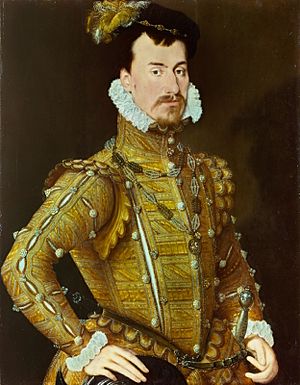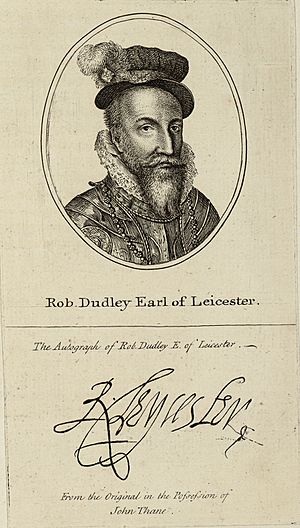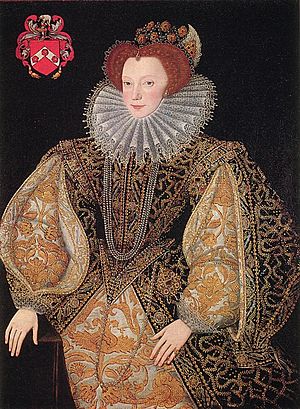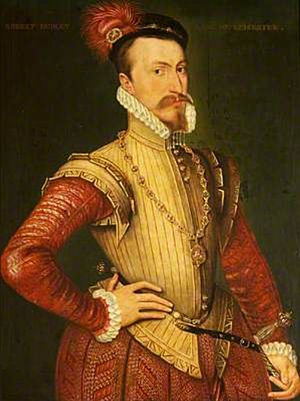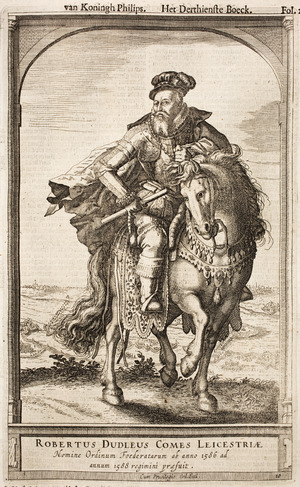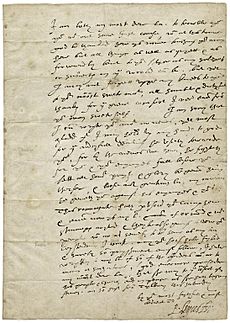Robert Dudley, 1st Earl of Leicester facts for kids
Quick facts for kids
The Earl of Leicester
|
|
|---|---|
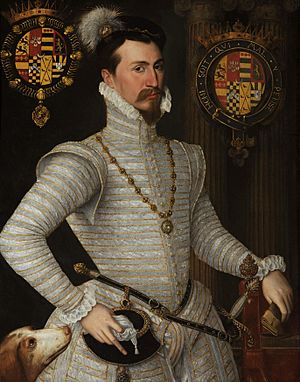
Robert Dudley, Earl of Leicester, c. 1564. In the background are the devices of the Order of Saint Michael and the Order of the Garter; Robert Dudley was a knight of both.
|
|
| Born | 24 June 1532 |
| Died | 4 September 1588 (aged 56) Cornbury, Oxfordshire, Kingdom of England |
| Resting place | Collegiate Church of St Mary, Warwick |
| Tenure | 1564–1588 |
| Other titles | Lord of Denbigh |
| Known for | Favourite of Elizabeth I |
| Nationality | English |
| Residence | Kenilworth Castle, Warwickshire Leicester House, London Wanstead, Essex |
| Locality | West Midlands North Wales |
| Wars and battles | Kett's Rebellion Campaign against Mary I, 1553 Battle of St. Quentin, 1557 Dutch Revolt Spanish Armada |
| Offices | Master of the Horse Lord Steward of the Royal Household Privy Councillor Governor-General of the United Provinces |
| Spouse(s) | Amy Robsart (m. 1550; d. 1560) Lettice Knollys (m. 1578) |
| Issue | Sir Robert Dudley (illegitimate) Robert Dudley, Lord of Denbigh |
| Parents | John Dudley, 1st Duke of Northumberland Jane Guildford |
| Signature | |
 |
|
Robert Dudley, 1st Earl of Leicester (born June 24, 1532 – died September 4, 1588) was an important English leader. He was a close friend and advisor to Elizabeth I, the Queen of England, from the time she became queen until he died. For many years, he hoped to marry the Queen.
Robert Dudley's early life was difficult. In 1553, his father, the Duke of Northumberland, tried to stop Mary I from becoming queen. This plan failed, and Robert's family faced serious trouble. Robert Dudley was sentenced to death, but he was released in 1554. He later fought in a battle in France, which helped him regain his good standing.
When Elizabeth I became Queen in November 1558, she quickly gave Robert Dudley an important job as Master of the Horse. This meant he was in charge of the Queen's horses and travel. He also became a privy councillor, a trusted advisor to the Queen. In 1564, he was given the title of Earl of Leicester. He became one of the biggest landowners in North Wales and the West Midlands of England.
The Earl of Leicester was a key statesman, helping Elizabeth with both English and foreign affairs. He supported the Protestant cause in Europe and led English forces helping the Dutch Revolt against Spain. He also played a major role during the Spanish Armada, leading England's land forces. He was known for organizing grand events for the Queen, like the famous festival at his home, Kenilworth Castle, in 1575. Robert Dudley also supported artists, writers, and theatre.
His personal life sometimes caused problems at court. When his first wife, Amy Robsart, died in 1560, there were rumors that he had arranged her death to marry the Queen. These rumors hurt his chances of marrying Elizabeth. He eventually married Lettice Knollys in 1578, which angered the Queen, and Lettice was banned from court.
Contents
Early Life and Challenges
Growing Up and First Marriage
Robert Dudley was the fifth son of John Dudley, 1st Duke of Northumberland, and his wife, Jane. His grandfather had been an advisor to King Henry VII. Robert's family was known for being happy. He had many tutors, including famous scholars like John Dee and Roger Ascham. Roger Ascham thought Robert was very good at languages, but Robert preferred math. He learned how to act at court while serving King Henry VIII and his son, Edward VI.
In 1549, Robert Dudley helped put down a rebellion called Kett's Rebellion. Around this time, he met Amy Robsart. They fell in love and married on June 4, 1550. King Edward VI was even there! Amy was the daughter of a gentleman-farmer from Norfolk. Robert's father, who was very powerful, was happy about the marriage because it helped him gain more influence in Norfolk. Robert became an important local gentleman and served as a Member of Parliament.
Imprisoned and Forgiven
On July 6, 1553, King Edward VI died. Robert's father tried to make Lady Jane Grey queen instead of Mary. Lady Jane Grey was married to Robert's younger brother, Lord Guildford Dudley. Robert Dudley led soldiers to Norfolk to support Jane. But Mary I gathered her own supporters, and Jane's short reign ended quickly.
Robert Dudley was sent to the Tower of London. He was found guilty of treason, just like his father and four brothers. His father was executed. While in the Tower, Robert was imprisoned at the same time as his childhood friend, Elizabeth, who was Mary's half-sister. Elizabeth was suspected of being involved in a rebellion. Robert's brother, Guildford, was also executed.
The remaining Dudley brothers were released later in 1554. Their mother and brother-in-law, Henry Sidney, worked hard to get them freed. They even made friends with Spanish nobles around Philip of Spain, who was Mary's husband.
In 1557, Robert and Amy Dudley got some of their lands back. Robert and his brothers, Ambrose and Henry, fought for Philip II in the Battle of St. Quentin in 1557. Sadly, Henry Dudley was killed in the battle. In 1558, Mary I's parliament officially restored all the surviving Dudley children's rights.
A Royal Friendship
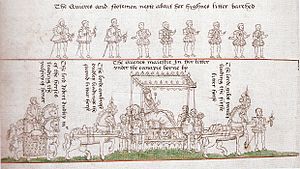
Just before Queen Mary died, people already saw Robert Dudley as one of Elizabeth's special friends. The day after Elizabeth became Queen, Robert was there when she received the Great Seal. He was made Master of the Horse that same day. This was a very important job, keeping him close to the Queen. He was excellent with horses and helped organize many royal events, including Elizabeth's coronation.
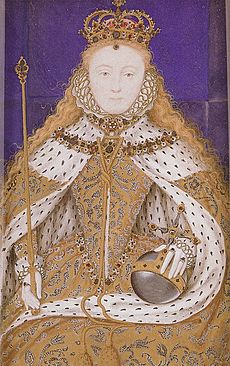
In April 1559, Dudley became a Knight of the Garter, a special honor. Soon, foreign visitors believed that Robert Dudley was one of the most powerful people in England. They thought he would become king because Elizabeth seemed so fond of him. Many nobles didn't like his new power. There were even rumors that Elizabeth and Robert had children together, and these rumors continued for years.
Amy Dudley's Death
People noticed that Elizabeth always kept Dudley by her side. But she did not show the same favor to his wife, Amy Dudley. Amy lived in different parts of the country. She visited London for a month in the summer of 1559, but she and Robert never saw each other again after that.
On September 8, 1560, Amy Dudley was found dead at her home near Oxford. She had fallen down a flight of stairs and broken her neck. Robert Dudley was at Windsor Castle with the Queen when it happened. He asked for a fair investigation, and a jury decided it was an accident. However, many people suspected that Robert had arranged his wife's death so he could marry the Queen. This scandal made it much harder for him to marry Elizabeth.
Hopes of Marriage to the Queen
Elizabeth remained close to Robert Dudley. He tried to marry her, with her encouragement. But the scandal of his wife's death and his father's past made it difficult. In 1561, Dudley even offered to leave England for military adventures, but Elizabeth didn't want him to go.
In October 1562, the Queen became very sick with smallpox. Thinking she might die, she asked her advisors to make Robert Dudley the "Protector of the Realm." Luckily, she recovered. Dudley then became a privy councillor, a formal advisor.
In 1563, Elizabeth suggested that Robert Dudley marry Mary, Queen of Scots, who was a widow. Elizabeth hoped this would create peace between England and Scotland. She even said she would recognize Mary as her heir if Mary married Robert. In 1564, Robert was made Earl of Leicester to make him seem more suitable for Mary. However, Robert Dudley made it clear he didn't want to marry Mary. He even helped Henry Stuart, Lord Darnley, who Mary eventually married. Elizabeth later said the marriage didn't happen because Leicester refused.
By 1564, Dudley realized his chances of marrying Elizabeth were small. But he also didn't want her to marry anyone else. Elizabeth continued to say she would marry him if she married an Englishman.
Life at Court
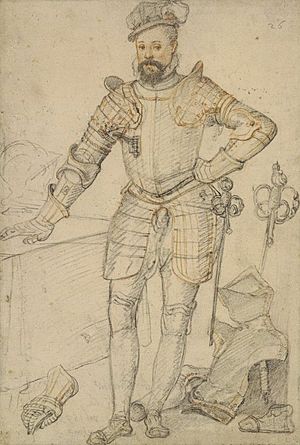
As a male favorite to a queen who never married, Robert Dudley was in a unique position. His rooms at court were next to hers, and he had great influence. Elizabeth was very possessive and jealous of him. She needed him around and for many years, he was rarely allowed to leave.
Dudley often acted like an unofficial partner to the Queen at ceremonies. He was in charge of court events and organized many parties and celebrations. From 1587, he was Lord Steward, responsible for supplying the royal household with food and other goods. He was good at saving money and making improvements in this role. Robert Dudley loved sports, including hunting, jousting, and tennis. He was also the Queen's regular dancing partner.
Kenilworth Castle and Ambition
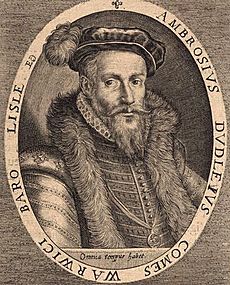
After his father's troubles, Robert Dudley had to rebuild his family's wealth. In 1560, Elizabeth gave him a special license to export goods, which earned him a lot of money. He also received some of his father's lands. In 1563, the Queen gave him Kenilworth Manor, Castle, and Park, as well as lands in North Wales. Robert and his older brother, Ambrose Dudley, 3rd Earl of Warwick, became very powerful landowners in the West Midlands and North Wales.
Denbighshire
In his new Welsh lands, Robert Dudley worked to fix land ownership problems. He made agreements with farmers, giving them more secure rights to their land in exchange for new rents. This helped both the farmers and his own income.
Even though he wasn't always there, Leicester cared about his lands in Wales. He started big building projects in the town of Denbigh. He also supported the translation of the Bible and the Common Prayer Book into Welsh.
Warwick and Kenilworth
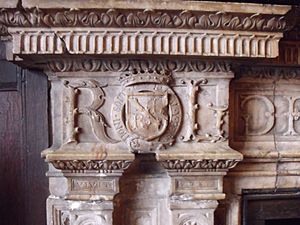
Robert and his brother Ambrose were very close. They were proud of their ancestors, including Richard Beauchamp, Earl of Warwick, a hero from the Hundred Years War. Robert and Ambrose adopted the old family symbol of the earls of Warwick, the Bear and Ragged Staff.
Robert Dudley made Kenilworth Castle the center of his plans. He made many changes to the castle, adding a new gatehouse, a formal garden, and a residential wing. These changes showed the new style of Elizabethan architecture. After the work was done, he held a huge 19-day festival in July 1575 for the Queen. It was a spectacular event with a Lady of the Lake, a swimming dolphin, fireworks, plays, hunts, and popular entertainment like bear baiting. The whole castle and grounds were used for the Queen's enjoyment.
Later Life and Family
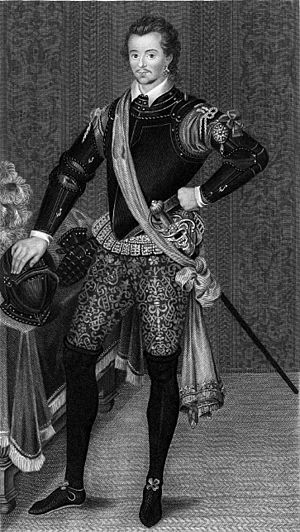
Robert Dudley had a relationship with Douglas Sheffield, a young widow, starting around 1569. He told her he couldn't marry her because it would upset the Queen and ruin his career. In 1574, Douglas gave birth to their son, also named Robert Dudley.
Lettice Knollys was the wife of Walter Devereux, 1st Earl of Essex, and a cousin of Queen Elizabeth. After her husband died in 1576, rumors spread that Leicester had poisoned him, though an investigation found no evidence of this.
On September 21, 1578, Leicester secretly married Lettice Knollys at his country home. He was afraid to tell the Queen. Nine months later, his enemies at court told Elizabeth, and she was furious. Leicester's hope for a child was fulfilled in 1581 when another Robert Dudley was born. Sadly, the child died at age three in 1584. Leicester was very sad but found comfort in his faith. He was a devoted husband to Lettice and cared for her children from her first marriage. He saw Robert Devereux, 2nd Earl of Essex, his stepson, as his political heir.
The Queen was deeply hurt by Leicester's marriage. She never accepted it and sometimes publicly humiliated him. But then she would be as fond of him as ever. In 1583, she called Lettice Dudley "a she-wolf" and her husband a "traitor." Lady Leicester's social life was very limited. Leicester stood by his wife, even though it caused him problems with the Queen.
Helping Explorers and the Arts
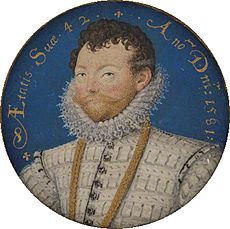
Robert Dudley was a leader in new industries. He was interested in many things, from tapestries to mining. He was involved in some of the first joint stock companies in England. He also cared about helping poor people find jobs and gave money to those in need.
He had strong connections with London's business leaders. He invested in trading companies like the Muscovy Company. He was very interested in the careers of John Hawkins and Francis Drake, and he was a main supporter of Drake's trip around the world. Robert and his brother Ambrose also supported Martin Frobisher's search for the Northwest Passage. Leicester even owned his own ship, the Galleon Leicester. He cared deeply about England's power at sea.
Learning, Theatre, and Literature
Robert Dudley was the Chancellor of Oxford University and was very dedicated to it. He helped set up the official Oxford University Press. He also supported scholars who taught new ideas.
About 100 books were dedicated to Robert Dudley during Elizabeth's reign. He was especially interested in translations, which helped more people learn. He also loved history. Robert Dudley was very involved in theatre. He had his own acting company, Leicester's Men, and in 1574, he got them the first royal permission to travel and perform. He also had a group of musicians.
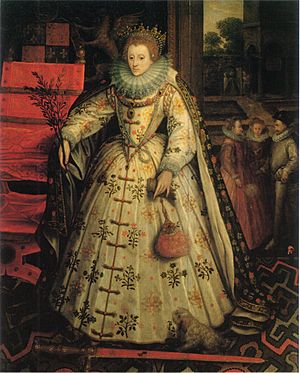
Leicester had one of the largest collections of paintings in England. He was a major supporter of the artist Nicholas Hilliard. His group of scholars and writers included his nephew Philip Sidney and the astrologer John Dee. The famous poet Edmund Spenser worked at Leicester's grand London home, Leicester House, and wrote some of his first poems there.
Religion
Robert Dudley grew up as a Protestant. He became a major supporter of Protestant leaders and those who had been exiled during Mary I's reign. He also helped some of Mary's former servants and kept Catholic friends. He strongly supported the Huguenot cause in France. After a terrible massacre of Protestants in France in 1572, he became an even stronger supporter of English Puritans and international Calvinism.
However, Leicester also had Catholics working in his household, showing that his loyalty was sometimes based on personal relationships as much as religion. He was very interested in promoting preaching, which was important to moderate Puritans. He supported preachers who didn't fully agree with the Church of England, but he warned them not to be too extreme. He believed the Church of England was "soundly and godly set forth." He tried to help different religious groups find common ground.
Leading in the Netherlands
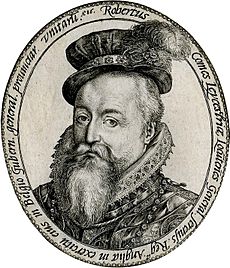
In the 1570s, Leicester became good friends with Prince William of Orange in the Netherlands. Leicester was popular there. He pushed for England to send military help to the Dutch rebels fighting against Spain. In 1584, Prince William was murdered, and the Dutch needed help more than ever. In August 1585, it was decided that Leicester would go to the Netherlands to lead their forces. He prepared by using his own money and borrowing a lot, about £25,000.
On December 9, 1585, Leicester sailed to the Netherlands. He was welcomed like a hero. On January 1, 1586, the Dutch leaders asked him to accept the title of Governor-General of the United Provinces. Leicester accepted on January 25, before he heard back from England.
This new title meant Leicester had "general rule and government" over the Netherlands. He was still a subject of Queen Elizabeth, but the Dutch saw him as their leader. Elizabeth, however, was furious. She had not wanted to take control of the Netherlands. She sent a messenger to publicly tell Leicester to resign his post. This greatly damaged Leicester's reputation.
Elizabeth also told Leicester not to take any major actions against the Spanish forces, which was the opposite of what Leicester and the Dutch wanted. After some early successes, the important town of Grave surrendered unexpectedly. Leicester was so angry that he had the town's governor executed, which shocked the Dutch nobles.
Leicester's forces were small and didn't have enough money. Elizabeth was angry about the war's cost and delayed sending money and troops for months. This forced Leicester to spend even more of his own money, and his soldiers suffered greatly.
Many Dutch leaders were more focused on trade than religion. They became unhappy with Leicester's strong support for the Protestant religion. Leicester, following Elizabeth's orders, banned trade with Spain, which angered wealthy Dutch merchants. He also tried to reform their financial system.
In September 1586, Leicester's nephew, Philip Sidney, was wounded in a battle and died a few weeks later. Leicester was heartbroken. In December, Leicester returned to England. While he was away, two Catholic officers he had trusted gave important fortresses to the Spanish.
Leicester returned to the Netherlands in June 1587, but he couldn't get the Dutch allies to cooperate. The port of Sluis was lost to the Spanish. After this, Elizabeth decided to try for peace with Spain. By December 1587, the problems between Elizabeth, the Dutch, and Leicester were too great. He asked to be recalled by the Queen and left his post. He was deeply in debt because he had used so much of his own money to fund the war.
Spanish Armada and Death
In July 1588, as the Spanish Armada approached England, the Earl of Leicester was put in charge of the Queen's land armies. He set up a camp at Tilbury on the Thames River to defend London if the Spanish landed. Leicester worked hard to organize the troops. When the Queen visited her soldiers and gave her famous speech, Leicester walked beside her horse.
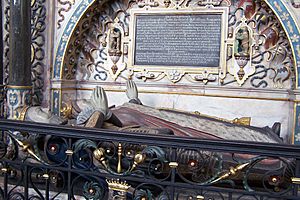
After the Armada was defeated, Leicester was seen riding through London in great style. For the last few weeks of his life, he often ate dinner with the Queen, which was a very special honor. He died on September 4, 1588, near Oxford, while on his way to take the baths for his health. Historians think he may have died from malaria or stomach cancer. His death was unexpected.
Elizabeth was deeply affected by his death. She locked herself in her rooms for days. Her special nickname for Dudley was "Eyes." She kept the last letter he sent her, written six days before he died, in her bedside treasure box. It was still there when she died 15 years later.
Leicester was buried in the Beauchamp Chapel of the Collegiate Church of St Mary, Warwick, as he had wished. His wife, Countess Lettice, was also buried there when she died in 1634, next to her "best and dearest of husbands."
Images for kids
See also
 In Spanish: Robert Dudley para niños
In Spanish: Robert Dudley para niños



